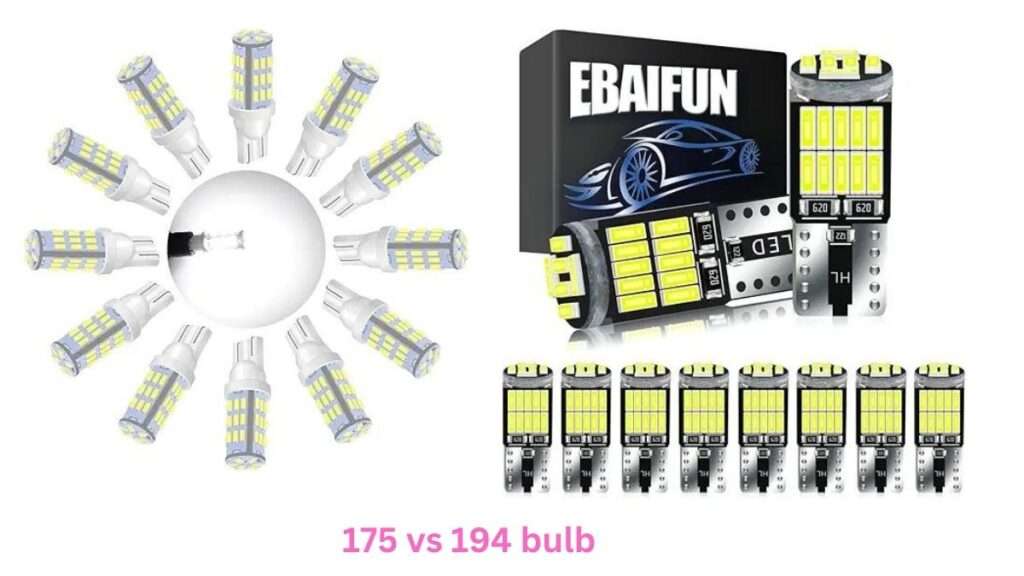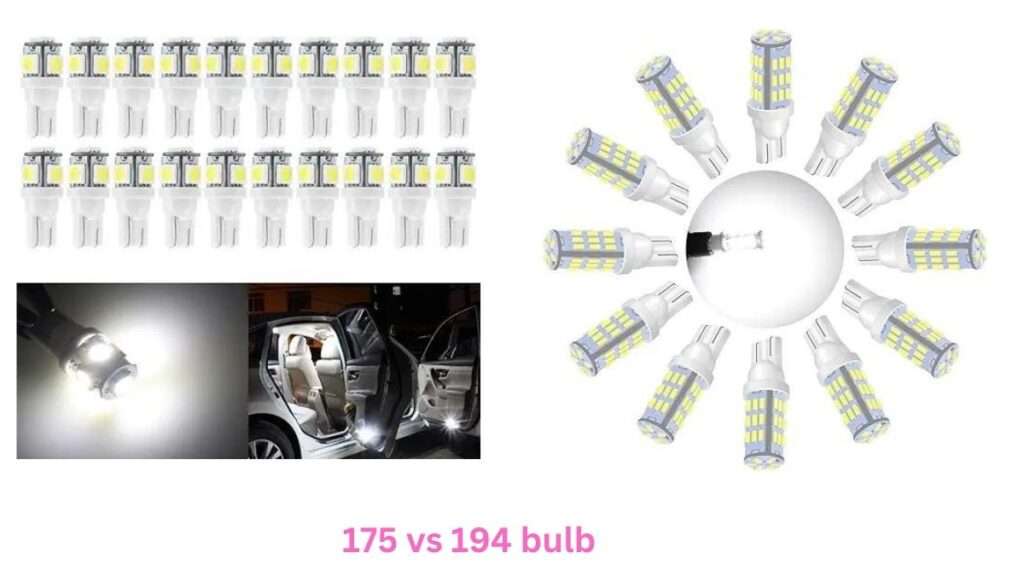When it comes to automotive lighting, understanding the differences between various bulbs is crucial. Today, we’re diving into a detailed comparison between two popular types: the 175 bulb vs 194 bulb. Whether you’re a car enthusiast looking for optimal lighting or just someone trying to replace a burnt-out bulb, this guide will help you understand these two options better. We’ll cover everything from dimensions and brightness to energy efficiency and legal considerations, giving you all the information you need to make an informed decision.
Understanding the Basics: What Are 175 and 194 Bulbs?
i). Definition and Classification of 175 Bulbs
The 175 bulb is primarily known as a halogen bulb used in automotive lighting. It falls under the broader category of miniature bulbs, designed for specific uses in vehicle lighting systems. This bulb type is often used for exterior vehicle lighting, such as turn signals, taillights, and some interior lights. It operates using halogen gas, which increases its light output compared to older incandescent bulbs.
ii). Overview of 194 Bulbs and Their Characteristics
The 194 bulb is smaller and more commonly used in low-power applications like dashboard lights, license plate illumination, and interior dome lights. These bulbs are usually made with either incandescent or LED technology. They are known for their versatility and energy efficiency, making them popular in various automotive lighting applications.
iii). Brief History and Development of These Bulb Types
The 175 bulb has its roots in halogen technology, which was a significant improvement over incandescent bulbs in terms of brightness and efficiency. Halogen bulbs became popular in the 1970s and have been a staple in automotive lighting ever since. On the other hand, the 194 bulb was originally an incandescent bulb but has seen a shift toward LED technology in recent years due to advancements in energy efficiency and lifespan.
iv). Common Misconceptions About Automotive Bulbs
One common misconception is that brighter bulbs are always better. While brightness is important, factors like energy consumption, lifespan, and compatibility with your vehicle’s electrical system are equally critical. Another misconception is that all bulbs of the same size will work in any socket. In reality, compatibility depends on factors like voltage, wattage, and fitment specifications.
Size Matters: Dimensions and Fitment Comparison
i). Detailed Measurements of 175 Bulbs
The 175 bulb typically measures around 1.2 inches in length and has a base diameter of approximately 0.5 inches. This makes it a relatively small bulb, ideal for various automotive applications where space is limited. Its compact size also means it can be used in tight areas without obstructing other vehicle components.
ii). Size Specifications for 194 Bulbs
The 194 bulb is even smaller, measuring about 1 inch in length with a base diameter of around 0.4 inches. Its compact size makes it perfect for smaller sockets, such as those found in dashboard lights and interior lighting. Because of its small footprint, the 194 bulb is highly versatile and can fit into many different types of vehicles.
iii). How Size Affects Installation and Compatibility
Size is crucial when it comes to automotive bulbs because it directly impacts compatibility with your vehicle’s lighting system. A bulb that’s too large won’t fit in the socket, and one that’s too small may not provide a secure connection. Always check your vehicle’s manual or consult with a professional to ensure you’re choosing the correct size.
iv). Tips for Checking Your Vehicle’s Bulb Fitment Requirements
To avoid fitment issues, consult your vehicle’s owner manual, which usually lists the bulb types compatible with your model. You can also use online tools or visit an auto parts store to cross-reference bulb sizes and fitment requirements.
Illuminating the Difference: Brightness and Light Output
i). Lumens and Wattage of 175 Bulbs
The 175 bulb typically produces around 320 lumens with a wattage of 4.6 watts. Lumens measure the total light output, making this bulb relatively bright for its size. It’s ideal for exterior applications where more light is needed, such as turn signals or parking lights.
ii). Light Output Characteristics of 194 Bulbs
The 194 bulb, on the other hand, produces around 25 lumens if incandescent or up to 200 lumens for LED versions. Its wattage is significantly lower, typically around 3 watts. The lower light output makes it suitable for interior lighting or other applications where less brightness is required.
iii). Comparison of Brightness Levels Between the Two
When comparing the two, the 175 bulb is noticeably brighter than the 194 bulb, especially in its halogen form. However, modern LED 194 bulbs can offer competitive brightness while consuming less energy. The choice between the two depends on the specific lighting needs of your vehicle.
iv). Factors Affecting Perceived Brightness in Vehicles
The perceived brightness of a bulb can be affected by factors like the design of the reflector, the cleanliness of the lens, and even the color temperature of the light. For example, a bulb with a cooler (bluer) light may appear brighter than a warmer (yellow) one, even if the lumens are the same.
Power Consumption: Energy Efficiency Face-Off
i). Energy Usage of 175 Bulbs
The 175 bulb consumes around 4.6 watts of power, which is relatively efficient for a halogen bulb. However, compared to LED options, it does draw more energy, which can put additional strain on your vehicle’s electrical system, especially if you have multiple halogen bulbs installed.
ii). Power Draw of 194 Bulbs
The 194 bulb, particularly in its LED form, is much more energy-efficient, drawing only about 3 watts or less. This lower power consumption makes it an attractive option for those looking to reduce the electrical load on their vehicle.
iii). Impact on Vehicle Electrical Systems
Excessive power consumption from multiple high-wattage bulbs can cause your vehicle’s electrical system to overwork, potentially leading to battery drain or alternator issues. Choosing energy-efficient bulbs like LED 194s can help reduce this strain.
iv). Long-Term Cost Implications of Each Bulb Type
While the 175 bulb may be cheaper upfront, its higher energy consumption can result in increased fuel costs over time. In contrast, the energy efficiency of the 194 LED bulb can save you money on fuel and bulb replacements in the long run.
Lifespan and Durability: Which Bulb Lasts Longer?
i). Average Lifespan of 175 Bulbs
The typical lifespan of a 175 halogen bulb is around 500 to 1,000 hours. While this is decent for a halogen bulb, it pales in comparison to LED alternatives, which can last significantly longer.
ii). Durability Factors for 194 Bulbs
LED 194 bulbs are known for their durability and can last up to 50,000 hours. They are also more resistant to vibration and temperature fluctuations, making them ideal for automotive use.
iii). Comparison of Longevity Between the Two Types
When comparing longevity, LED 194 bulbs far outlast halogen 175 bulbs. If longevity and durability are your primary concerns, the 194 LED bulb is the clear winner.
iv). Tips for Maximizing Bulb Life in Automotive Applications
To extend the life of your bulbs, ensure proper installation, avoid touching the glass with your fingers, and keep your vehicle’s electrical system in good condition. Regular cleaning of lenses and reflectors also helps improve bulb performance.
Application Guide: Where to Use 175 and 194 Bulbs
1. Common Uses for 175 Bulbs in Vehicles
The 175 bulb is commonly used in exterior lighting applications, such as turn signals, taillights, and parking lights. It’s bright enough to provide visibility in these key areas.
2. Typical Applications of 194 Bulbs
The 194 bulb is more often used in interior lighting, dashboard illumination, license plate lights, and sometimes in small exterior lights like side markers. Its compact size and lower brightness make it suitable for these less demanding applications.
3. Vehicle Models and Makes Compatible with Each Type
Both 175 and 194 bulbs are widely used across various makes and models of vehicles. Always consult your vehicle manual to ensure compatibility before making a purchase.
4. Considerations for Aftermarket Modifications
If you’re considering aftermarket lighting upgrades, such as switching from halogen to LED, ensure that the bulbs are compatible with your vehicle’s electrical system and won’t trigger warning lights or other issues.
Installation Process: DIY or Professional Job?
i). Step-by-Step Guide for Installing 175 Bulbs
1. Turn off the vehicle and open the hood or trunk, depending on the bulb location.
2. Locate the bulb socket and twist it counterclockwise to remove it.
3. Replace the old bulb with the new 175 bulb.
4. Test the new bulb before securing the socket.
ii). Instructions for Replacing 194 Bulbs
1. Access the bulb socket by removing any covering panels.
2. Twist the socket counterclockwise to remove the old bulb.
3. Insert the new 194 bulb, ensuring it’s securely in place.
4. Test the bulb before reassembling any covers.
iii). Tools Required for Each Installation
Both installations typically require basic tools like a screwdriver and gloves to avoid touching the bulbs directly. For some vehicles, you may need a socket wrench.
iv). When to Seek Professional Help for Bulb Replacement
If you’re unsure about wiring or the bulb’s compatibility with your vehicle’s electrical system, it’s always safer to consult a professional.
v). Long-Term Cost Savings from Choosing the Right Bulb
While LED bulbs may have a higher upfront cost, their longer lifespan and energy efficiency can result in significant savings over time.
Legal and Safety Considerations
1. Regulations Surrounding Automotive Bulbs
Both 175 and 194 bulbs must meet specific regulations set by organizations like the Department of Transportation (DOT) to ensure they are safe for use in vehicles.
2. Safety Tips for Choosing and Installing Bulbs
Always choose bulbs that meet DOT standards to ensure safety and compliance. Improperly installed or incompatible bulbs can result in electrical issues or reduced visibility, which can be dangerous.
3. Potential Risks of Using Incorrect Bulbs
Using the wrong type of bulb can lead to electrical problems, reduced visibility, and even fines for non-compliance with safety regulations. Always double-check fitment and compatibility before installing a new bulb.
Conclusion: Making the Right Choice Between 175 vs 194 Bulbs
Choosing between the 175 vs 194 bulbs depends on your specific needs. If you require bright, exterior lighting, the 175 bulb is a solid choice. However, if you’re looking for energy efficiency and longer lifespan, especially for interior or less demanding applications, the 194 LED bulb is a better option. Always consider factors like brightness, power consumption, and fitment before making your final decision.
By understanding the differences between these two bulbs, you can make an informed choice that enhances your vehicle’s lighting performance and efficiency.
Related articles:
Hi, I’m Malik Suhail—an SEO expert, web designer, and passionate blogger with 2 years of experience. I specialize in crafting content that is not only informative but also tailored to meet the needs of my readers.
I write about diverse topics, always striving to simplify complex ideas and provide valuable insights that resonate with my audience. Whether it’s about SEO strategies, web design trends, or blogging tips, I am committed to delivering well-researched, practical, and easy-to-understand information.
My mission is to help readers navigate the digital world with confidence and clarity. I believe in adding value through authentic content that inspires action and delivers results.


